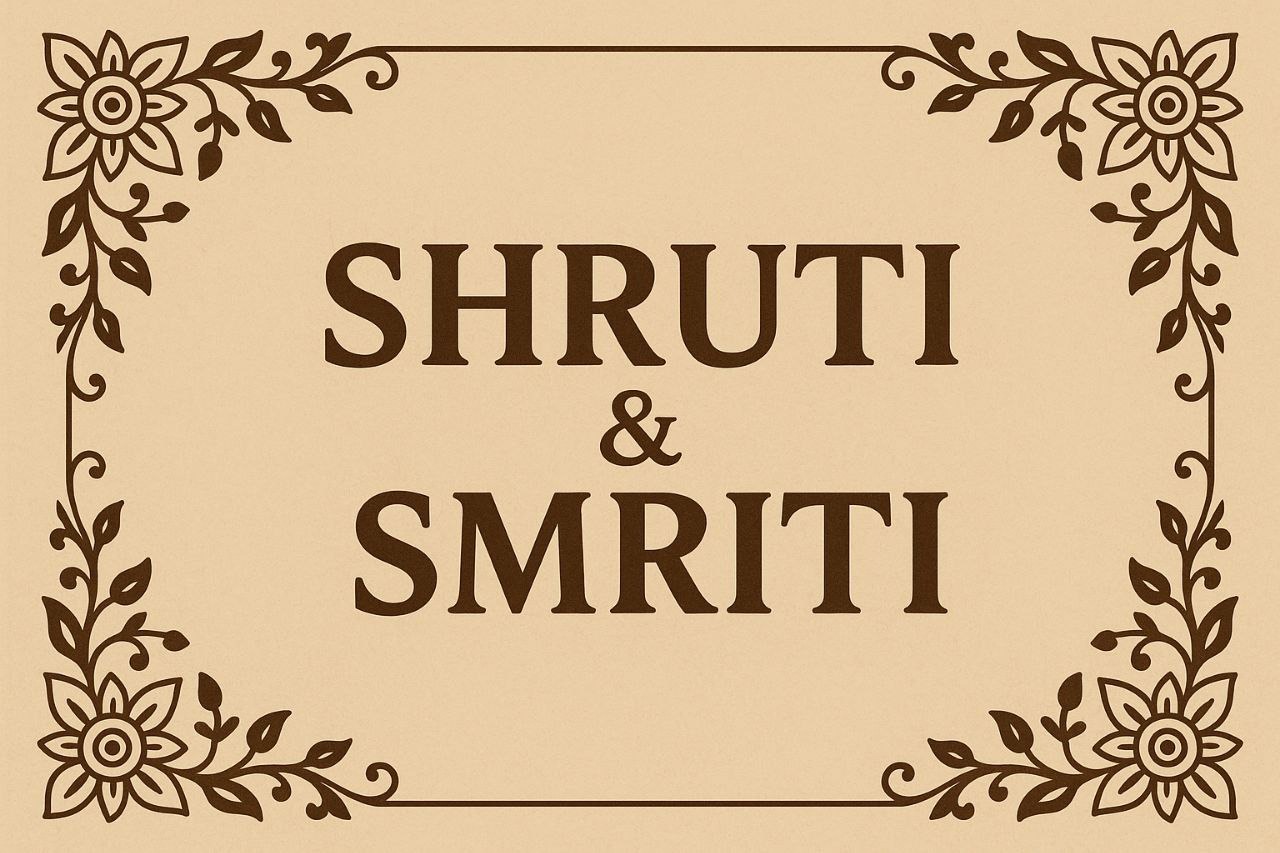Shruti & Smriti ~ Two Pillars of Scriptural Wisdom

Sanātan Dharma, commonly known as Hinduism, is not just a religion but a timeless path of divine realization.
Its foundation rests upon two timeless pillars of scriptural wisdom: Shruti and Smriti.
Like the heartbeat and breath of spiritual civilization, they preserve eternal truths and translate them into practical living.
To understand Hindu philosophy, dharma, rituals, and ethics, one must first grasp these two categories of sacred texts.
Shruti is the eternal voice of revelation, while Smriti is the echo of memory, both indispensable, both divine.
What is Shruti?
Shruti (श्रुति) means "that which is heard." It refers to divinely revealed knowledge that was heard by ancient ṛṣis (sages) during profound states of meditation and spiritual absorption. Shruti is not considered the work of any author, it is apauruṣeya (not of human origin).
Core Texts within Shruti:
The Vedas (Ṛgveda, Yajurveda, Sāmaveda, Atharvaveda) ~ Eternal mantras and hymns
The Brahmanas ~ Ritual expositions linked to the Vedas
The Āraṇyakas ~ Philosophical insights for forest-dwelling seekers
The Upaniṣads ~ Pure Vedānta and spiritual essence
Shruti forms the unchanging metaphysical framework of Sanātana Dharma and is revered as the highest authority in the scriptural hierarchy.
"Shruti is the timeless whisper of Truth, caught in silence by the soul of a sage." ~ Adarsh Singh
What is Smriti?
Smriti (स्मृति) means "that which is remembered." These are sacred texts composed by sages and seers who drew inspiration from the eternal truths of Shruti and reinterpreted them in ways applicable to human society and historical contexts.
Core Texts within Smriti:
Manusmriti, Yājñavalkya Smriti, and Parāśara Smriti ~ Dharmaśāstras or codes of law and conduct
Rāmāyaṇa and Mahābhārata ~ Epic Itihāsas
Bhagavad Gītā ~ Philosophical scripture within the Mahābhārata
Purāṇas ~ Theological and Epic narratives
Tantras and Āgamas ~ Worship, rituals, and esoteric teachings
Smriti is contextual, flexible, and dynamic, making it suitable for application in evolving societies.
While Shruti is pure truth, Smriti is the truth applied.
"If Shruti is the eternal flame, Smriti is its gentle glow in the world of action." ~ Adarsh Singh
Shruti vs. Smriti: Core Differences
1. Meaning:
Shruti means "that which is heard," indicating truths revealed directly by the Divine.
Smriti means "that which is remembered," signifying texts composed by sages based on divine memory and human experience.
2. Origin and Authority:
Shruti is apauruṣeya, divinely revealed and therefore supreme in authority.
Smriti is of human origin, even though inspired by Shruti, and thus holds secondary authority.
3. Language and Expression:
Shruti is composed in the archaic and poetic Vedic Sanskrit, often cryptic and layered.
Smriti is more narrative and accessible, using classical Sanskrit to relate stories, instructions, and ethical codes.
4. Subject Focus:
Shruti deals with universal principles, metaphysics, rituals, and deep spiritual knowledge.
Smriti translates those principles into social norms, ethics, governance, customs, and everyday living.
5. Flexibility:
Shruti is considered eternal and unalterable.
Smriti is adaptable and revisable, depending on time, place, and societal need, yet always rooted in Shruti’s core truth.
6. Examples:
Texts like the Vedas and Upaniṣads belong to Shruti.
The Manusmriti, Mahābhārata, Rāmāyaṇa, Purāṇas, and Tantras belong to Smriti.
"Shruti is the heartbeat of the cosmos; Smriti is the rhythm of the culture." ~ Adarsh Singh
Harmony Between Shruti and Smriti
Rather than opposing forces, Shruti and Smriti work together like sunlight and its reflection. Shruti gives the divine blueprint, and Smriti applies it to the human condition. For instance, the Bhagavad Gītā, while part of the Smriti literature, conveys the non-dual wisdom of the Upaniṣads, part of Shruti.
Ancient sages knew that timeless truths must be adapted for time-bound societies. Hence, Smriti serves as the bridge between transcendence and tradition, absolute and applicable.
"As the sky is constant and the clouds are ever-shifting, Shruti is the sky, and Smriti the clouds reflecting its light." ~ Adarsh Singh
Relevance in the Modern Age
For spiritual seekers, Shruti offers transcendental truths and guidance for liberation.
For ethical guidance, Smriti provides frameworks for justice, social harmony, and righteous conduct.
For devotees, Smriti through Purāṇas and epics paints a relatable picture of divine play (Lila) and dharma in action.
For scholars and reformers, understanding the interplay between Shruti and Smriti is key to evolving tradition without losing its soul.
"In an age drowning in noise, the Shruti teaches us to listen, and the Smriti teaches us to live." ~ Adarsh Singh
Shruti and Smriti are not separate paths, but two expressions of the same eternal consciousness.
True understanding of Sanātana Dharma arises when one learns to hear the Shruti in the silence of the soul, and to honor the Smriti in the footsteps of daily life.
"Shruti shows us the path to the infinite; Smriti teaches us how to walk it with grace." ~ Adarsh Singh
Shruti is the pure source, the silence behind the sound; Smriti is the living stream, the sound that flows through culture.
"In every age, the eternal calls through Shruti, and the timely responds through Smriti. To ignore either is to be half-blind in the journey of truth." ~ Adarsh Singh
Mon Jul 21, 2025
